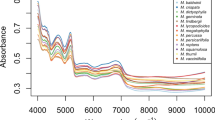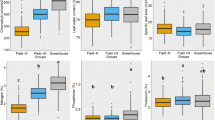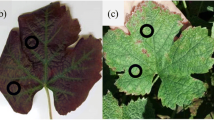Abstract
Real-time spot spraying of weed patches requires the development of sensors for the automatic detection of weeds within a crop. In this context, the potential of UV-induced fluorescence of green plants for corn-weed discrimination was evaluated. A total of 1 440 spectral signatures of fluorescence were recorded in a greenhouse from three plant groups (four corn hybrids, four dicotyledonous weed species and four monocotyledonous weed species) grown in a growth chamber. With multi-variate analysis, the full information contained in each spectrum was first reduced to the scores calculated from five principal components. Then, a linear discriminant analysis was applied on these scores to classify spectra on a species/hybrids basis and, subsequently, the resulting classes were aggregated according to the three plant groups. This two-step process minimized the error generated by heterogeneous groups such as dicotyledonous weeds. The output of this classification shows the significant potential of UV-induced fluorescence for plant group discrimination as the success rate reached 91.8%. No error was observed between corn and dicot weeds and most of the errors between corn and grasses came from confusion between the hybrid Pioneer 39Y85 and Setaria glauca L. (Beauv.). Analysis also determined that the position of the fluorescence sensor on the leaf and the plant age had negligible effects on the efficiency of fluorescence to discriminate plant groups. The factors to consider for transferring the results about UV-induced fluoro-sensing from laboratory to the field are discussed.






Similar content being viewed by others
Notes
Scientific name not mentioned in the original paper (Hilton 2000).
Newport Corporation-Oriel Products, Stratford, CT, USA.
Andor Technology PLC, Belfast, Northern Ireland.
References
Agati, G., Mazzinghi, P., Fusi, F., & Ambrosini, I. (1995). The F 685/F 730 chlorophyll fluorescence ratio as a tool in plant physiology: Response to physiological and environmental factors. Journal of Plant Physiology, 145(3), 228–238.
Anonymous. (2003). Portrait régionaux des populations de mauvaises herbes présentes dans les cultures au Québec. Montérégie-Est, (Regional profiles of weed populations present in Quebec crops) ROMH, Direction de l’innovation scientifique au MAPAQ. http://www.mapaq.gouv.qc.ca/NR/rdonlyres/6E38B439-68F7-4BF7-936D-85B5A88D3065/0/2001_indices_monteregieest.pdf. Accessed 28 May 2009.
Anonymous. (2004). Proceedings of the 2nd international workshop on remote sensing of vegetation fluorescence. St-Hubert, Qc: Canadian Space Agency. 17–19 Nov.
Anonymous. (2006). Crop life Canada. Annual Report 2005–2006. http://www.croplife.ca/web/pdfs/annualreports/annualreport05-6-eng.pdf. Accessed 28 May 2009.
Benhamou, N., & Bélanger, R. (1998). Induction of systemic resistance to Pythium damping off in cucumber plants by benzothiadiazole: Ultrastructure and cytochemistry of the host response. The Plant Journal, 14(1), 13–21.
Bongi, C., Palliotti, A., Rocchi, P., Moya, I., & Goulas, Y. (1994). Spectral characteristics and a possible topological assignment of blue green fluorescence excited by UV laser on leaves of unrelated species. Remote Sensing of Environment, 47, 55–64.
Bown, A. W., Hall, D. E., & MacGregor, K. B. (2002). Insect footsteps on leaves stimulate the accumulation of 4-aminobutyrate and can be visualized through increased chlorophyll fluorescence and superoxide production. Plant Physiology, 129, 1430–1434.
Brown, R. B., & Noble, S. D. (2005). Site-specific weed management: Sensing requirements—what do we need to see? Weed Science, 53, 252–258.
Burd, J. D., & Elliott, N. C. (1996). Changes in chlorophyll and fluorescence induction kinetics in cereals infested with Russian wheat aphid (Homoptera: Aphididae). Journal of Economic Entomology, 89, 1332–1337.
Cartelat, A., Cerovic, Z. G., Goulas, Y., Meyer, S., Lelarge, C., Prioul, J.-L., et al. (2005). Optically assessed contents of leaf polyphenolics and chlorophyll as indicators of nitrogen deficiency in wheat (Triticum aestivum L.). Field Crop Research, 91(1), 35–49.
Cerovic, Z. G., Samson, G., Morales, F., Tremblay, N., & Moya, I. (1999). Ultraviolet-induced fluorescence for plant monitoring: Present state and prospects. Agronomy, 19(7), 543–578.
Chambers, J. M., Cleveland, W. S., Kleiner, B., & Tukey, P. A. (1983). Graphical methods for data analysis. 395 pp., Wordsworth, Belmont, California, 60-63.
Chappelle, E. W., Wood, F. M., McMurtrey, J. E., & Newcomb, W. W. (1985). Laser-induced fluorescence of green plants. 3: LIF spectral signature of five major plant types. Applied Optics, 24(1), 74–80.
Chishaki, N., & Horiguchi, T. (1997). Responses of secondary metabolism in plants to nutrient deficiency. Soil Science and Plant Nutrition, 43, 987–991.
Chou, H.-M., Bundock, N., Rolfe, S. A., & Scholes, J. D. (2000). Infection of Arabidopsis thaliana leaves with Albugo candida (white blister rust) causes a reprogramming of host metabolism. Molecular Plant Pathology, 1(2), 99–113.
Dahn, H. G., Günther, K. P., & Lüdecker, W. (1992). Characterisation of drought stress of maize and wheat canopies by means of spectral resolved laser induced fluorescence. EARSeL Advances in Remote Sensing, 1, 12–19.
DeLorenzo, M. E., Scott, G. I., & Ross, P. E. (2001). Toxicity of pesticides to aquatic microorganisms: a review. Environmental Toxicology and Chemistry, 20(1), 84–98.
Eriksson, L., Johansson, E., Muller, M., & Wold, S. (2000). On the selection of the training set in environmental QSAR analysis when compounds are clustered. Journal of Chemometrics, 14, 599–616.
Felton, W. L., & McCloy, K. R. (1992). Spot spraying. Agricultural Engineering, 11(9), 12.
Freemark, K., & Boutin, C. (1995). Impacts of agricultural herbicide use on terrestrial wildlife in temperate landscapes: A review with special reference to North America. Agriculture, Ecosystems & Environment, 52(2), 67–91.
Gitelson, A. A., Buschmann, C., & Lichtenthaler, H. K. (1999). The chlorophyll fluorescence ratio F735/F700 as an accurate measure of the chlorophyll content in plants. Remote Sensing of Environment, 69(3), 296–302.
Goulas, Y., Cerovic, Z. G., Cartelat, A., & Moya, I. (2004). Dualex: A new instrument for field measurements of epidermal ultraviolet absorbance by chlorophyll fluorescence. Applied Optics, 43(23), 4488–4496.
Hahn, E., & Muir, A. Y. (1994). Spectral sensing for crops and weed discrimination. Acta Horticulturae, 372, 179–186.
Haile, F. J., Higley, L. G., Ni, X., & Quisenberry, S. S. (1999). Physiological and growth tolerance in wheat to Russian wheat aphid (Homoptera: Aphididae) injury. Environmental Entomology, 28, 787–794.
Heisel, F., Sowinska, M., Miehé, J. A., Lang, M., & Lichtenthaler, H. K. (1996). Detection of nutrient deficiencies of maize by laser induced fluorescence imaging. Journal of Plant Physiology, 148, 622–631.
Hilton, P. J. (2000). Laser-induced fluorescence for discrimination of crops and weeds. Proceedings of SPIE, 4124, 223–231.
Jansen, M. A. K., Gaba, V., & Greenberg, B. M. (1998). Higher plants and UV-B radiation: Balancing damage, repair and acclimation. Trends in Plant Science, 3(4), 131–135.
Kohavi, R., & Provost, F. (1998). Glossary. Machine Learning Journal, 30, 271–274.
Kouril, R., Lazar, D., Ilik, P., Skotnica, J., Krchnak, P., & et Nauš, J. (2004). High-temperature induced chlorophyll fluorescence rise in plants at 40–50°C: experimental and theoretical approach. Photosynthesis Research, 81(4), 9–66.
Lamm, R., Slaughter, D., & Giles, D. (2002). Precision weed control system for cotton. Transactions of the ASAE, 45(1), 231–238.
Lichtenthaler, H. K., & Miehé, J. A. (1997). Fluorescence imaging as a diagnostic tool for plant stress. Trends in Plant Science, 2(8), 316–320.
Lichtenthaler, H. K., & Schweiger, J. (1998). Cell wall bound ferulic acid, the major substance of the blue-green fluorescence emission of plants. Journal of Plant Physiology, 152, 272–282.
Litjens, R., Quickenden, T., & Freeman, C. (1999). Visible and near-ultraviolet absorption spectrum of liquid water. Applied Optics, 38(7), 1216–1223.
Lüdeker, W., Dahn, H. G., & Gunther, K. P. (1996). Detection of fungal infection of plants by laser-induced fluorescence: an attempt to use remote sensing. Journal of Plant Physiology, 148, 579–585.
Lutman, P., & Perry, N. H. (1999). Methods of weed patch detection in cereal crops. Weeds, 1-3, 627. Brighton conference, British Crop Protection Council, UK.
Mahalanobis, P. C. (1936). On the generalized distance in statistics. Proceedings of the National Institute of Sciences of India, 12, 49–55.
Manh, A., Rabatel, G., Assemat, L., & Aldon, M. (2001). AE-Automation and emerging technologies weed leaf image segmentation by deformable templates. Journal of Agricultural Engineering Research, 80(2), 139–146.
Martens, H., & Naes, T. (1996). Multivariate calibration. New York: Wiley.
Matlab™. (2007). The MathWorks Headquarters 3 Apple Hill Drive, Natick, MA.
Maxwell, K., & Johnson, G. N. (2000). Chlorophyll fluorescence—a practical guide. Journal of Experimental Botany, 51(345), 659–668.
Mercure, S.-M., Daoust, B., & Samson, G. (2004). Causal relationship between growth inhibition, accumulation of phenolic metabolites, and changes of UV-induced fluorescences in nitrogen-deficient barley plants. Canadian Journal of Botany, 82(6), 815–821.
Meyer, S., Cartelat, A., Moya, I., & Cerovic, Z. G. (2003). UV-induced blue-green and far-red fluorescence along wheat leaves: A potential signature of leaf ageing. Journal of Experimental Botany, 54(383), 757–769.
Morales, F., Cerovic, Z. G., & Moya, I. (1996). Time-resolved blue-green fluorescence of sugar beet (Beta vulgaris L.) leaves. Spectroscopic evidence for the presence of ferulic acid as the main fluorophore of the epidermis. Biochimica et Biophysica Acta, 1273(25), 1–262.
Morales, F., Cerovic, Z. G., & Moya, I. (1998). Time-resolved blue-green fluorescence of sugar beet leaves. Temperature-induced changes and consequences for the potential use of blue-green fluorescence as a signature for remote sensing of plants. Australian Journal of Plant Physiology, 25, 325–334.
Ngouajio, M., Lemieux, C., Fortier, J. J., Careau, D., & Leroux, G. D. (1998). Validation of an operator-assisted module to measure weed and crop leaf cover by digital image analysis. Weed Technology, 12(3), 446–453.
Norikane, J. H., & Kuruta, K. (2001). Water stress detection by monitoring fluorescence of plants under ambient light. Transactions of the ASAE, 44(6), 1915–1922.
Ounis, A., Cerovic, Z. G., Briantais, J.-M., & Moya, I. (2001). Dual excitation FLIDAR for the estimation of epidermal UV absorption in leaves and canopies. Remote Sensing of Environment, 76, 33–48.
Ryer, A. (1997). Light measurement handbook. Newburyport, MA: International Light.
Scholes, J. D., & Rolfe, S. (1996). Photosynthesis in localised regions of oat leaves infected with crown rust (Puccinia coronata): quantitative imaging of chlorophyll fluorescence. Planta, 1999, 573–582.
Schuster, I., Nordmeyer, H., & Rath, T. (2007). Comparison of vision-based and manual weed mapping in sugar beet. Biosystems Engineering, 98, 17–25.
Shaw, D. R. (2005). Remote sensing and site-specific weed management. Frontier in Ecology and Environment, 3(10), 526–532.
Slaughter, D., Giles, D., & Downey, D. (2008). Autonomous robotic weed control systems: A review. Computers and Electronics in Agriculture, 61(1), 63–78.
Stafford, J. V. (2000). Implementing precision agriculture in the 21th century. Journal of Agricultural Engineering Research, 76, 267–275.
R Development Core Team (2005). R: A language and environment for statistical computing. R Foundation for Statistical Computing, Vienna, Austria. ISBN3-900051-07-0. http://www.R-project.org. Accessed 28 May 2009.
Timmermann, C., Gerhards, R., & Kuhbauch, W. (2003). The economic impact of site-specific weed control. Precision Agriculture, 4(3), 249–260.
USDA (2006). Seed not for planting, p. 3–12, Table 3–7. http://www.aphis.usda.gov/import_export/plants/manuals/ports/downloads/seeds_not_for_planting.pdf. Accessed 28 May 2009.
Venables, W. N., & Ripley, B. D. (2002). Modern applied statistics with S (4th ed., p. 495). New York: Springer.
Walter, H., & Koch, W. (1980). Light reflectance characteristics of weed and crop leaves as affected by plant species and herbicides. In Proceedings 1980 British Crop Protection Conference—Weeds. pp. 243–250.
Weisa, M., & Gerhards, R. (2007). Feature extraction for the identification of weed species in digital images for the purpose of site-specific weed control. In J. V. Stafford (Ed.), Precision agriculture ‘07, Proceedings of the 6th European Conference on Precision Agriculture, The Netherlands: Wageningen Academic Publishers, pp. 537–544.
Wise, B., Gallagher, N. B., Bro, R., Shaver, J. M., Windig, W., & Koch, R. (2006). PLSToolbox 4.0—Reference Manual for use with Matlab. Eigenvector Research Inc.
Acknowledgments
We thank Gilles St-Laurent and Marlène Piché for their help during the experiments. We appreciate Susanne Buhler for her technical help. This research was financially supported by the Natural Sciences and Engineering Research Council of Canada.
Author information
Authors and Affiliations
Corresponding author
Rights and permissions
About this article
Cite this article
Longchamps, L., Panneton, B., Samson, G. et al. Discrimination of corn, grasses and dicot weeds by their UV-induced fluorescence spectral signature. Precision Agric 11, 181–197 (2010). https://doi.org/10.1007/s11119-009-9126-0
Received:
Accepted:
Published:
Issue Date:
DOI: https://doi.org/10.1007/s11119-009-9126-0




